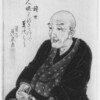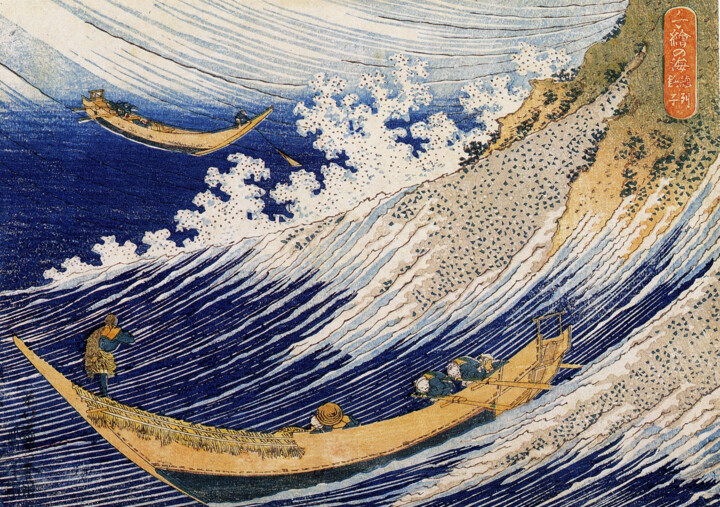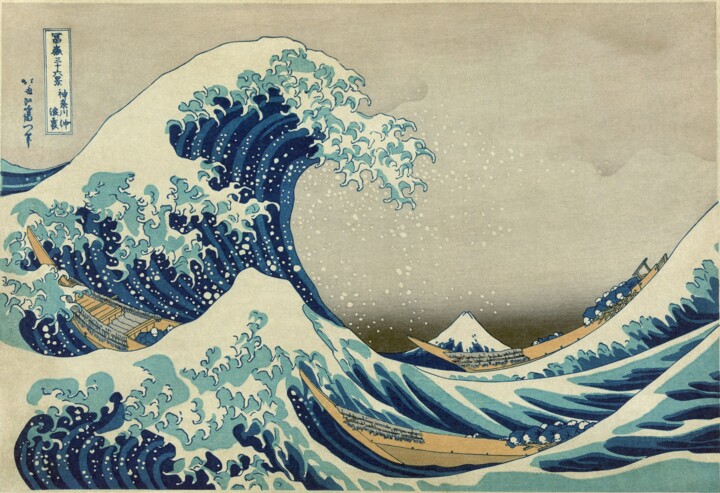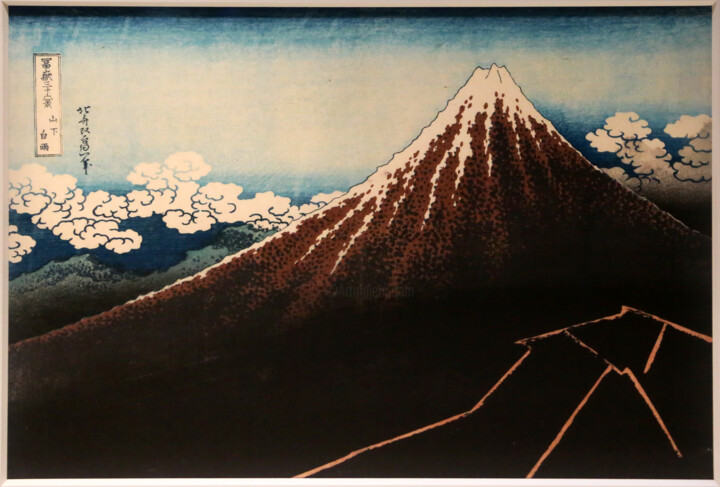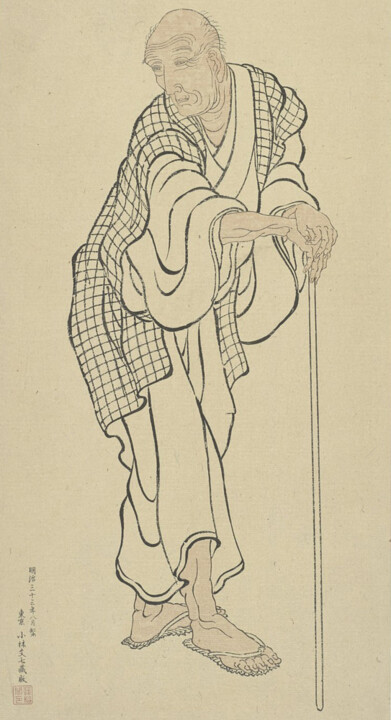 Hokusai, self-portrait at the age of eighty-three
Hokusai, self-portrait at the age of eighty-three
Who is Katsushika Hokusai?
Katsushika Hokusai was born on October 31, 1760 in Edo, the ancient capital of Japan, now known as Tokyo. He was adopted by his uncle was a mirror maker named Nakajima Isen. His name is actually Tokitarō.
He began his artistic training at an early age. At age 14, he began his apprenticeship with Katsukawa Shunshō, a master of the Katsukawa school, famous for his ukiyo-e prints. During this period, he learned the techniques of woodcut, as well as painting and drawing.
In 1779, at the age of 19, Hokusai published his first set of prints under the name Shunrō, an artist name derived from his master's name. He continued to work and study under Katsukawa Shunshō until the latter's death in 1793. Thereafter, Hokusai studied other artistic styles, such as those of the Kano school and Western artists, which influenced his style and techniques.
During this period, Hokusai primarily focused on kabuki prints, a popular genre of the time that depicted theater actors and scenes from plays. He also made erotic prints (shunga) and illustrations for novels and poems. However, his works from this time largely reflected the style of his master and the Katsukawa school.
The beginnings of the career
Hokusai had a rough start trying to make a name for himself and establish his own artistic identity. Early in his career, he made kabuki prints and illustrations for books, but his work was heavily influenced by his teacher Katsukawa Shunshō and the other artists of the Katsukawa school. Determined to find his own way and his perseverance paid off, and in the early 19th century he began to experience his first successes.
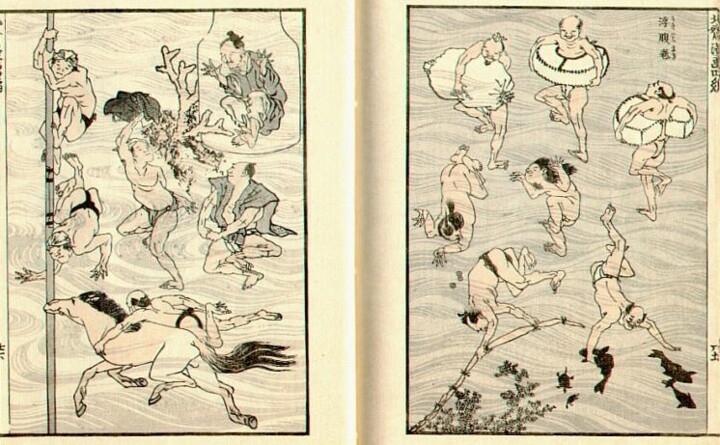 Bathing, Manga, Hokusai
Bathing, Manga, Hokusai
Hokusai's early successes include series of prints such as "Hokusai Manga" and "A Tour of the Waterfalls of the Provinces". "Hokusai Manga", a collection of sketches and drawings, was published in 15 volumes between 1814 and 1878 and was very popular in Japan. "A Tour of the Waterfalls of the Provinces", published in 1832, is a series of landscapes depicting waterfalls in different regions of Japan.
Published in 1799, "Kyōka Edo no Murasaki" contains kyōka poems that depict daily life and customs in the Edo period, with a light and humorous tone. Hokusai's illustrations for this collection were well received and drew attention to his artistry. This success helped Hokusai establish his reputation as an artist and illustrator, and paved the way for new artistic opportunities and accomplishments during his career.
Hokusai traveled throughout Japan, seeking inspiration for his artwork. These trips not only nurtured his artistic talent, but also allowed him to learn about various local cultures and Japanese traditions. By observing everyday life and landscapes, Hokusai was able to capture the essence of Japan and incorporate it into his ukiyo-e prints and other works of art.
The creator of many manga, the term was used differently in Hokusai's time than it is today. In the Edo period, "manga" simply meant "whimsical drawings" or "sketches". Hokusai published a series of books titled "Hokusai Manga", which included drawings and sketches on various topics, such as nature, animals, people, mythology, and everyday life. These works were published in 15 volumes between 1814 and 1878 and were very popular in Japan.
 Image from the series e-hon Raigo Ajari Kaisoden (The Mysterious Rat(s) of Priest Raigo), illustrated by Hokusai, circa 1808
Image from the series e-hon Raigo Ajari Kaisoden (The Mysterious Rat(s) of Priest Raigo), illustrated by Hokusai, circa 1808
End of career
Katsushika Hokusai continued to work and produce artwork despite her advanced age. In fact, some of his most iconic works were created during his later years. For example, his famous series "Thirty-six Views of Mount Fuji", which includes "The Great Wave off Kanagawa", was published between 1830 and 1833, when Hokusai was already 70 years old.
Hokusai never stopped exploring new techniques and seeking inspiration from various sources. He continued to create prints, paintings and drawings, and even produced instructional books for budding artists.
In the 1840s, towards the end of his life, Hokusai turned to painting, emphasizing large-format works and portraits of Buddhist and Shinto deities, as well as historical and mythological figures. He also made paintings of landscapes and flowers. This evolution towards painting shows Hokusai's constant desire to explore new forms of artistic expression and to expand his repertoire.
Katsushika Hokusai died on May 10, 1849 at the age of 88.
Private life of the artist
Katsushika Hokusai's personal life was quite complicated, and the available information about her family is sometimes contradictory. However, it is known that Hokusai married twice and had several children.
His first marriage was in 1777 to a woman whose name is not well documented. Together they had two sons and three daughters. One of his sons, Shinsuke, died very young. The other son, Tominosuke, worked as an artist, but did not achieve success comparable to his father.
After the death of his first wife, Hokusai remarried in 1797 to a woman named Yosano Oyō. The couple had two daughters. One of them, Ōi, was also an artist and worked closely with her father. Ōi was talented, particularly in the fields of painting and printmaking, and she sometimes served as Hokusai's assistant. Some works attributed to Hokusai may actually be the work of his daughter Ōi.
7 incongruous things to know about Hokusai
Name Changes: During his lifetime, Hokusai changed his artist name more than 30 times. Each name change often reflected an evolution in his style and artistic vision.
Lost works: Hokusai created many works throughout his life, but many of them were lost or destroyed, especially due to fires and natural disasters.
Frequent Moves: Hokusai was known to move often. According to some sources, he moved more than 90 times during his life. The reasons for these moves are diverse, ranging from his dissatisfied nature to financial problems.
Hokusai and the West: The art of Hokusai had a significant impact on Western artists, especially French Impressionists like Claude Monet, who owned several Japanese prints, including some by Hokusai.
- Screen Painter: Hokusai also worked as a screen painter in the early years of his career. He made paintings for traditional Japanese folding screens called "byōbu", which were used to divide rooms and create privacy.
- Learning to Carve: Although Hokusai is primarily known for his prints and paintings, he also learned to carve during his lifetime. This may have influenced the way he depicted shapes and volumes in his graphic works.
- Student Turned Rival: Keisai Eisen was once a student of Hokusai, but the two artists eventually became rivals. Eisen was a talented ukiyo-e artist in his own right, and although he studied under Hokusai, he developed his own style and achieved some notoriety in the Japanese art world.
When does he take the name Hokusai?
Katsushika Hokusai adopted the name Hokusai around 1798, when he was around 39 years old. This name is derived from two words: "Hoku", which means "north", and "sai", which refers to a meal offered to the Buddha. This name change coincides with an important period of transition in his artistic career, marked by the search for his own style and the exploration of various techniques and artistic influences. Under this new name, Hokusai became one of Japan's most famous artists and produced some of his most iconic works, including the "Thirty-six Views of Mount Fuji" series.
famous series
Katsushika Hokusai is particularly famous for his series of ukiyo-e prints:
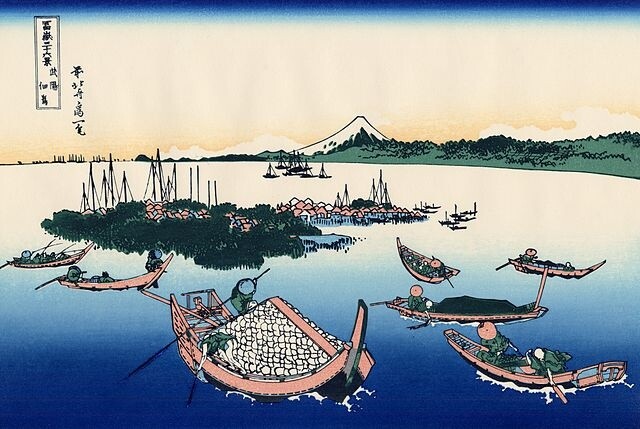 Tsukada Island in Musashi Province, No. 16
Tsukada Island in Musashi Province, No. 16
Thirty-six Views of Mount Fuji (富嶽三十六景, Fugaku Sanjūrokkei): This series, published between 1830 and 1833, includes 46 prints (not 36, as its title suggests) depicting Mount Fuji from different angles and in various weather conditions. The most famous work in this series is "The Great Wave off Kanagawa".
One Hundred Views of Mount Fuji (富嶽百景, Fugaku Hyakkei): This is another series devoted to Mount Fuji, produced between 1834 and 1835. Consisting of three volumes, it shows Mount Fuji from different angles and in various contexts.
Hokusai Manga (北斎漫画): This 15-volume series, published between 1814 and 1878, collects a large number of drawings and sketches by Hokusai on various subjects, such as nature, animals, people, mythology and everyday life. Although these works are not manga in the modern sense of the term, they had a significant impact on Japanese art and inspired many artists.
Unexpected Images of the Famous Sumida River (隅田川ちらし, Sumidagawa Chirashi): This series of prints, made between 1803 and 1807, depict picturesque scenes along the Sumida River in Edo (present-day Tokyo).
Eight Views of Ryūkyū (琉球八景, Ryūkyū Hakkei): This series of prints made in 1832 shows landscapes of the Ryūkyū archipelago (present-day Okinawa Islands) and highlights the beauty and diversity of the Japanese islands.
Famous works of Hokusai
The Great Wave off Kanagawa (神奈川沖浪裏, Kanagawa-oki Nami-ura): This iconic print, made circa 1830-1833, is part of the "Thirty-six Views of Mount Fuji" series. It depicts a huge wave threatening boats off Sagami Bay, with Mount Fuji in the background.
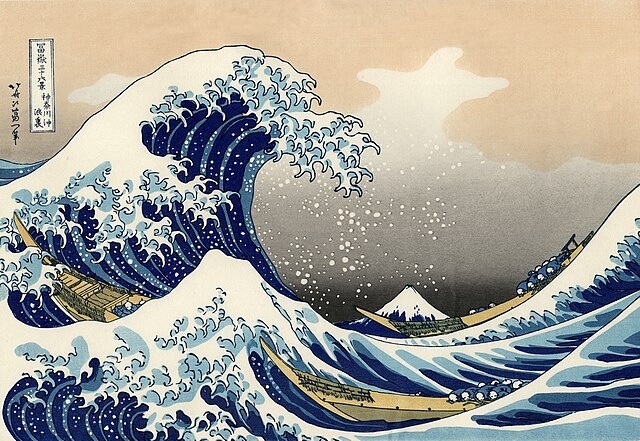
The Great Wave off Kanagawa, HokusaiFuji on a Clear Day , No. 33 (凱風快晴, Gaifū Kaisei), also known as Red Mount Fuji: Another print from the "Thirty-six Views of Mount Fuji" series, showing Mount Fuji under a clear with a reddish color.
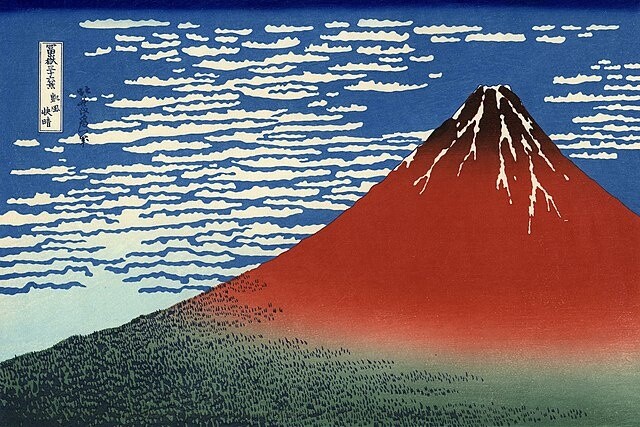
The Fuji on a Clear Day , No. 33, HokusaiView of Noboto Bay (登戸浦, Noboto-ura): This print is also part of the "Thirty-six Views of Mount Fuji" series and depicts fishermen at work on Noboto Bay, with Mount Fuji in the background -plan.
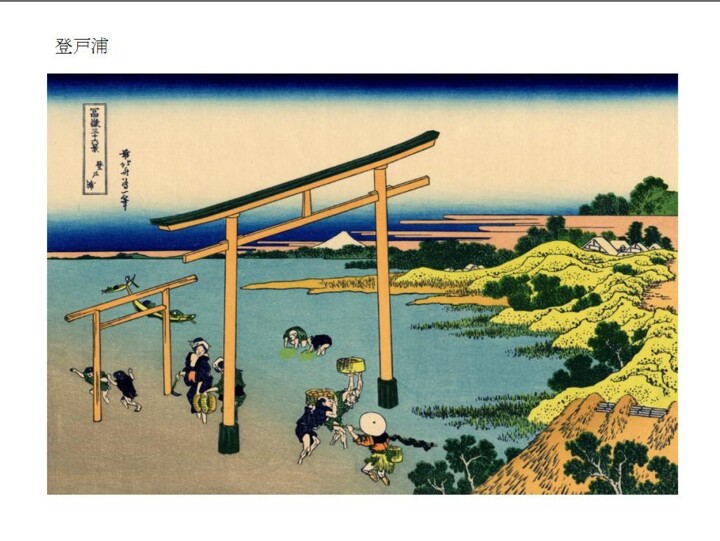
View of Noboto Bay, HokusaiLeaping Carp Fish (鯉の滝登り, Koi no Taki-nobori): This print is part of the "Hokusai Manga" series and depicts a group of carp leaping out of the water in an attempt to ascend a waterfall.

The jump of the carp fish, HokusaiThe Dream of the Fisherman's Wife (蛸と海女, Tako to Ama): This erotic print, also known as "The Octopus and the Diver", shows a woman surrounded by two octopuses. It is considered one of the first representations of eroticism in Japanese art and has inspired many artists thereafter.

The Dream of the Fisherman's Wife erotic print, 1814. HokusaiWaterfalls in Different Provinces (各省瀧廻り, Kakushū Taki Meguri): This series of eight prints, made around 1832, depicts different waterfalls in Japan. Dynamic compositions and color contrasts highlight the beauty and power of these natural phenomena.

The Kirifuri Waterfalls in the Kurokami Mountains in Shimotsuke , Hokusai
Artist Quotes
Katsushika Hokusai left a few quotes that give insight into her artistic philosophy and her constant quest for improvement:
"Since the age of six, I had a mania for drawing the shape of objects. Around the age of 50, I had published an infinity of drawings, but all that I produced before the age 70 years is not worth counting."
"At 73, I have roughly understood the structure of real nature, animals, grasses, trees, birds, fish and insects. Therefore, at 80, I will have done even more of progress; at 90, I will penetrate the mystery of things; at 100, I will surely have become marvelous, and at 110, each point, each line, will have a life of its own."
"If Heaven gives me another ten years, or even five, I will become a true artist."
Major Hokusai Exhibitions Around the World
Over the years, several major exhibitions dedicated to Hokusai have been held around the world, highlighting his work and his legacy. Here are some of the notable exhibits:
Grand Palais, Paris, France (2014): The "Hokusai (1760-1849)" exhibition at the Grand Palais featured more than 500 works by the artist, including prints, paintings and drawings, providing a comprehensive overview of his career and his artistic development.
British Museum, London, United Kingdom (2017): The exhibition "Hokusai: Beyond the Great Wave" explored the last period of the artist's career, focusing on his works made after 60 years. The exhibition included rare book prints, paintings and illustrations, as well as works by his contemporaries and students.
National Museum of Modern Art, Tokyo, Japan (2019): The "Hokusai Updated" exhibition featured over 1,200 works by the artist, including prints, paintings and drawings, as well as works by artists contemporaries influenced by Hokusai.
Asian Art Museum of San Francisco, USA (2020): The exhibition "Hokusai's Manga and Thirty-six Views of Mount Fuji" highlighted two of the artist's most famous series, "Hokusai Manga" and "Thirty-six Views of Mount Fuji", featuring prints, drawings and paintings.


 Selena Mattei
Selena Mattei
